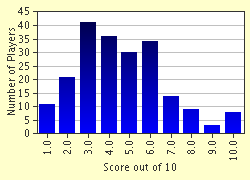Quiz Answer Key and Fun Facts
1. Turkeys originated in which of these areas?
2. Which tribe of Native Americans tells the tale of an enormous female turkey that brought them corn and taught them to cultivate the grain?
3. The Founding Fathers of America choose the bald eagle as a national symbol for our new country. Which statesman, however, thought that the turkey was a much better choice?
4. Baby turkeys are called which of these?
5. Wild turkeys can fly for short distances up to what speed?
6. What is the proper name for the wishbone of a turkey?
7. The average 15 pound turkey typically which of these proportions?
8. The long, fleshy growth that hangs down from the forehead over the turkey's beak has what name?
9. Turkeys can see movement at what approximate distance?
10. On a quiet day, a gobbling turkey can be heard at what distance?
Source: Author
donna399
This quiz was reviewed by FunTrivia editor
crisw before going online.
Any errors found in FunTrivia content are routinely corrected through our feedback system.


